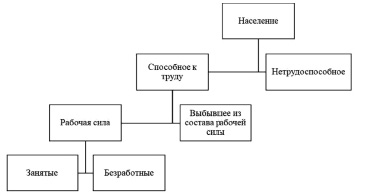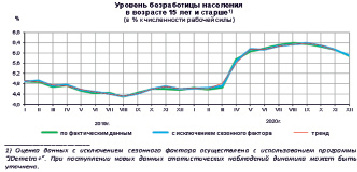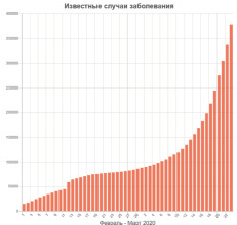Introduction and relevance
Unemployment is one of the most common factors that negatively affect people’s lives according to many criteria: financial income, living standards, satisfaction with living conditions, life expectancy, and others. Analysis of the reasons that increase or, conversely, lower the unemployment rate is of constant interest to government authorities and non-profit organizations, which aim is to reduce this level.
One of the main factors affecting the unemployment rate in recent years has been the pandemic of Covid-19. Intuitively, this dependence seems to be important, which is why it became the object of research in this article.
Based on the relevance of this topic, the research question can be formulated as follows: What is the value of Covid-19 on the unemployment rate in Russia and what consequences did the pandemic lead to?
The main hypothesis that we will try to prove will be: “Is it true that in the last 2 years the incidence of Covid-19 has the greatest impact on the unemployment rate in Russia in the context of other underlying factors?”
First, it is necessary to define the understanding of the category of “unemployment”. Let us set that unemployment is a socio-economic phenomenon characteristic of all modern states without exception, in which part of the country’s population cannot find a job. The unemployment rate in the country is determined by the percentage ratio of the number of citizens not employed in labor activities that generate income (unemployed) to the total number of the economically active population in the period under review. Depending on the reasons for the occurrence, economists distinguish the following types of unemployment: frictional, structural, cyclical, seasonal.
Each of the four types of unemployment has its own background and trends.
Unemployment can take the following four forms:
Open unemployment – means the official dismissal (firing) of an employee, a complete loss of work and income.
Hidden unemployment means that the employee fulfills his official duties, the first – in accordance with the contract (agreement) with the employer for part-time or part-time work, the second, without registration (salary that is paid ender the table) because cannot find another full-time job.
Fluent unemployment. It is associated with periodic fluctuations in the number of employed labor force available in the labor market.
Long-term unemployment is unemployment in long run that alternates with short periods of temporary work.
But, in our study, we will look at the impact of Covid-19 on the trends in the unemployment process in our country as a whole and analyze the impact of the pandemic on the overall trend of rising / falling unemployment.
Theoretical expectations
The theoretical and methodological approaches to the study of the problem of unemployment in a pandemic are based on fundamental general scientific theories, considering a systematic approach to the study of the problems of employment, unemployment and the labor market in general. The methodology of our research is based on the implementation of the most important process of development and formation of civil society, where employment is the most important criterion for the protection of an individual, providing him with maximum social optimism. Also, the methodological basis for the work was the analysis of regulatory documents governing the activities of employment services in the Russian Federation, specifically, the Ministry of Labor of the Russian Federation, as well as documents of state statistics.
The empirical basis of the study was made up of legislative and regulatory acts, including regional, statistical data on the Russian Federation and the Voronezh region, as well as information provided in the works of Russian and foreign researchers, materials from periodicals.
Immediately after the collapse of the Soviet Union, a document was adopted, the existence of which during the Soviet period was difficult to imagine. The Law of the Russian Federation of 9.04.1991 N 1032-1 “On employment of the population in the Russian Federation” was adopted, where in Art. 3. “The procedure and conditions for recognizing citizens as unemployed” is spelled out: 1. Unemployed are able-bodied citizens who do not have work and earnings, are registered with the employment service in order to find a suitable job, are looking for a job and are ready to start it [1]. In terms of economic activity, the population is divided into several groups, based on common characteristics, for example, by sex or age [2]. We add that not all non-working residents are considered unemployed, namely:
– not appropriate for working age (children, pensioners);
– people with physical disabilities (disabled);
– staying in places of deprivation of liberty.
All other people are included in the labor force. They either actually work (able-bodied population), or they can do it, but they do not want for some reason (they are not ready to start work or do not at all strive for this, for example, because of an inheritance sufficient for life).
Economically active citizens (labor force) do not fully consist of employed people, even in the ideal conditions of Russian reality. This is because, in any case, there is a category of unemployed.
In modern Russian practice, it is customary to refer to unemployed citizens:
– men aged 16 to 65 and women aged 16-62;
– citizens registered in employment centers to search for vacancies.
– dismissed citizens who are systematically looking for work;
– citizens who are ready to start working (but temporarily not working for formal reasons: paperwork, moving to a new place of residence, changing positions, transferring to another post, etc.).
These citizens must apply and register with the employment center. Thus, statistics show that, at best, only 45-62 % of the total population of the country are employed. According to the approaches of the International Labor Organization (ILO), the unemployed are persons at the age established for measuring the economic activity of the population (15 years and older, from January 2017, until this period 15-72), who in the period under review simultaneously satisfy the criteria:
– do not have a job (profitable occupation);
– are looking for work in the four weeks preceding the survey week, using any means;
– ready to start work during the surveyed week.
Analysis of some indicators of the unemployment rate for 2019-2021
The unemployment rate in Russia is currently quite high and raises serious concerns. In the first year of the pandemic and the introduction of related isolation measures, over 835 thousand Russians lost their jobs, and this is considering the constant drop in the birth rate. At this rate, the unemployment rate can reach a critical value [3].
It is necessary to highlight the features of the functioning of unemployment in Russia:
– The unemployment rate among rural residents is higher than the unemployment rate among urban residents. In January 2020, 6.5 % of rural residents versus 4.1 % of urban residents.
– The unemployment rate among young people is higher than among the older population.
– not all unemployed are registered with the employment service. For example, on the eve of the pandemic, in January 2020, 700 thousand people were registered as unemployed in the employment service (according to the Federal Service for Labor and Employment – Rostrud), and 3.5 million people were unemployed according to the ILO methodology [3,4].
The number of unemployed in Russia in 2020, according to preliminary data, amounted to about 4.321 million people. These figures are 24.7 % higher than in 2019. The total share of unemployed among the working-age population in 2020 was 5.9 %. It is becoming obvious that due to the 2020 crisis, the number of unemployed has increased by almost 1.2 times, which can be associated with the outbreak [5] and an increase in the incidence of the population from Covid-19 (fig. 2 and 3).

Fig. 1. Economic classification of citizens of the Russian Federation

Fig. 2. Level of unemployed people of 15 years and older

Fig. 3. Recorded cases of COVID-19
The above graph clearly shows that by April 2020, the situation with the coronavirus in Russia had become critical [5]. The number of unemployed in May 2020 rose to 6.1 % of the total labor force, the highest value since 2012. In general, since the beginning of the pandemic, more than 1 million citizens have been unemployed. In annual terms (in relation to May 2019), the growth in unemployment was about 32.7 %, compared to April – 5.3 % [3, 5].
In 2021, the unemployment rate in Russia reached 5.9 %. According to statistics, at the end of 2020, the working-age population of the Russian Federation amounted to 80.6 million people, 75.6 million of whom are economically employed, that is, they are officially employed. The rest of the population (about 4.32 million people) is classified as “unemployed” [5]. Unfortunately, the statistical analysis of the dynamics of this process throughout the entire pandemic period shows a steady increase, which, of course, cannot but be alarming.
The pandemic led to the temporary as well as permanent closure of many enterprises that provide the Russian economy with vacancies, which was a strong shock to the labor market. Almost half of the employed were exposed to the risks of layoffs and forced vacations. About 35 million people were at risk.
During the pandemic, the number of unemployed in Russia increased and amounted to 4.8 million people – 6.4 % of the economically active population of the country. According to official data from the Ministry of Labor, unemployment rose by 1.7 % compared to the level before the outbreak of the coronavirus. Hidden unemployment can reach a record 12 %, analysts from the audit and consulting bureau FinExpertiza calculated.
Result analysis
In modern conditions, the correlation between the pandemic crisis and the huge growth rates of unemployment in Russia is becoming obvious. The labor market seeks to adapt to the current situation by introducing a shorter working day, reducing wages, as well as transferring the maximum number of employees to the so-called “remote work” – working online. The alarming picture looks like this. Because of the quarantine measures, many were transferred to this form of work – remote work, while the salary was cut to the level of the minimum wage – 12 thousand rubles. However, from time to time, this only worsens the situation, because the percentage of people, especially elderly people, who confidently use a PC, are ready and can work online is by no means large. We add that in the higher education system, not all teachers were ready for distance learning. The level of compensation for deficiencies in the system of advanced training, re-profiling of the teaching staff through webinars, videoconferences, etc. leaves much to be desired. And the software of higher education organizations, to put it mildly, does not quite meet modern requirements for the training of high-level specialists.
It is quite clear that the measures taken by employers are not enough to effectively tackle the pandemic crisis. Considering inflation, the general level of wages decreased so much for the first time since 2016 [6].
So, there is an urgent need to reorganize the activities of government bodies, including the Ministry of Labor and Social Protection of the Russian Federation, Employment Centers, regional departments of labor and employment.
Conclusion
It is known that during crises there is growing attention to unemployment indicators, which carry with them many important signals. This information must be prompt, as detailed and accurate as possible in order to develop adequate policy measures [7].
Unemployment is undoubtedly reflected in the decline in the country’s economic growth. That is why it is so important to make the most of the possibilities of the state employment policy for the introduction of all available measures to reduce the unemployment rate [8].

